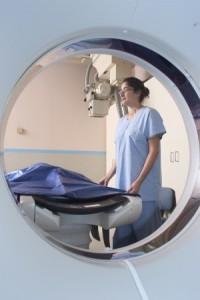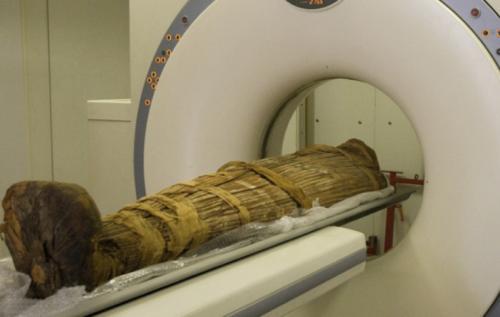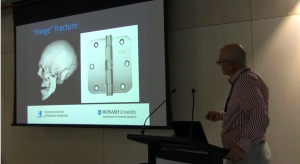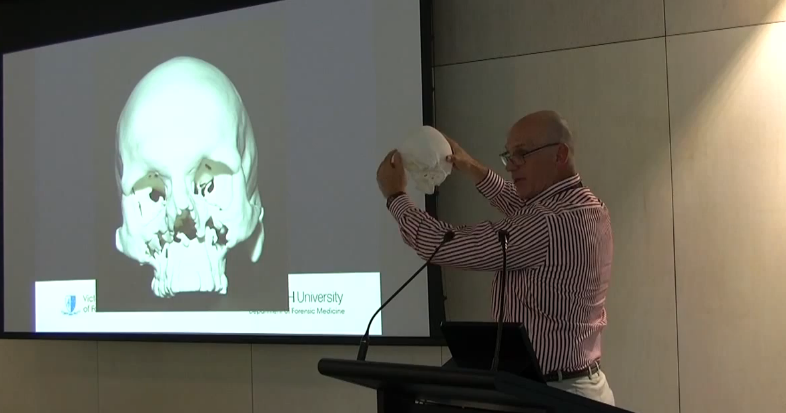The benefits of 3D technologies aren’t reserved only for the living. The Victorian Institute of Forensic Medicine’s (VIFM) Medico-Legal Death Investigation in Australia are working to demonstrate the benefits of producing 3D prints to serve as evidence in court. Members of their investigative team are regularly called upon to provide evidence and expert testimony in cases ranging from car accidents to homicide.
The forensic radiology team at the VIFM incorporated a CT scanner into the mortuary in 2005 and in the years since each deceased individual to be admitted to the institute has been scanned and the images stored in a growing database. Having the CT scanner on site has become a regular part of the routine at VIFM and has contributed to a reduction in the number of unnecessary autopsies performed there. In some cases, this means that the families who have lost their loved ones can have the remains returned to them in a much more timely fashion while also minimizing the need for invasive operations. While this may seem a small comfort during a time of loss, it is a comfort nonetheless.
This is not the first time that CT technology and the resulting 3D images have been collected from the deceased as an investigative tool. In 1975, the Toronto General Hospital acquired the first CT scanner in the city and it shortly thereafter was utilized to scan the body of an adolescent in an effort to learn more about his life and death. The body had belonged to a 15-year-old boy, a Theban weaver, who had died sometime during the 20th Dynasty [1187 BCE to 1064 BCE] and whose mummy had become part of the Egyptian collection at the Royal Ontario Museum.
In a presentation at Monash University as part of the 3D Printing for Medical Applications Seminar given earlier in April, Dr. Chris O’Donnell from VIFM made the case for and discussed the barriers to the use of 3D imagery and, more importantly, physical models that convey the forensic information from much more recent deaths to the jury, lawyers, judges, and defendants in a case. Currently, VIFM performs scans on approximately 6,000 bodies per year and the evidence gathered does so without disturbing the bodies in the least. The bodies are scanned while still in the bag and the evidence gathered can be provided to the court in a number of ways.
Dr. O’Donnell’s argument is that the production of 3D prints from the CT scan data allows for a greater understanding by laypeople of that which could only be described in words or two-dimensional imagery before. The example he provided related to a case in which an individual who had been involved in a car accident had come forward onto the car dash in such a way that the front of their upper jaw was shattered and the top of their skull lifted backwards in what is known as a hinge injury. To make his point, he first used only words to describe the injury, then showed black and white images, then images that had been colored and labeled.
He also showed an image that would have appeared in court which was a top down view in a color photograph of the head of the victim with the upper portion of their skull removed. While the image was sufficiently horrible, it was still difficult for me to understand exactly how this injury had lifted the skull (aside from the very obvious fact that it was gone). A 3D animation of the scanned skull was useful, but it wasn’t until he held up the 3D print of the skull and was able to point to and manipulate the place of injury that I was able to clearly see what the words he had used actually meant.
There are still some kinks to be worked out in the system in order for 3D printing to become fully integrated as part of the evidence provided by VIFM. There is, understandably, some resistance from attorneys to the emotional impact of such a presentation. The main issue, however, is one of education it seems. When the bodies arrive at the VIFM mortuary, they are often twisted or bent in ways related to the injuries they had sustained. The team at VIFM does not attempt to straighten them out or clean them up in any way as that might have a negative impact on the collection of data about pre-mortem injuries. Instead, they manipulate the imagery after collection.
The very use of the word “manipulate” has been enough to throw up barriers to the use of this evidence in court. It appears that this might be more an issue of semantics rather than actual shifts in the evidence. However, Dr. O’Donnell recognizes the weight of the word and a great deal more work will have to be done in order to demonstrate the difference between post-processing and evidence manipulation.
That is simply a matter of time and of the legal system becoming more accustomed to the use of 3D printing as a means of conveying information. The door has been opened and there will be no putting the lid back on Pandora’s Box. As technology advances so do the questions of philosophy and ethics faced by the humans who utilize it. These questions will be much more difficult to answer because, as of yet, we haven’t found any tool that can analyze them apart from the human mind.
Let us know what you think of this use of 3D printing as it relates to such legal and sensitive issues in the 3D Printing to Investigate Death forum thread over at 3DPB.com.
Subscribe to Our Email Newsletter
Stay up-to-date on all the latest news from the 3D printing industry and receive information and offers from third party vendors.
You May Also Like
3D Printing Unpeeled: New Arkema Material for HP, Saddle and Macro MEMS
A new Arkema material for MJF is said to reduce costs per part by up to 25% and have an 85% reusability ratio. HP 3D HR PA 12 S has been...
3D Printing News Briefs, January 20, 2024: FDM, LPBF, Underwater 3D Printer, Racing, & More
We’re starting off with a process certification in today’s 3D Printing News Briefs, and then moving on to research about solute trapping, laser powder bed fusion, and then moving on...
3D Printing Webinar and Event Roundup: December 3, 2023
We’ve got plenty of events and webinars coming up for you this week! Quickparts is having a Manufacturing Roadshow, America Makes is holding a Member Town Hall, Stratafest makes two...
Formnext 2023 Day Three: Slam Dunk
I’m high—high on trade show. I’ve met numerous new faces and reconnected with old friends, creating an absolutely wonderful atmosphere. The excitement is palpable over several emerging developments. The high...



































